Look up
allocution in Wiktionary, the free dictionary.
In the Roman Catholic Church, a papal allocution (from the Latin allocutio, a commander's battle speech to his troops) is a solemn, private form of address or speech employed by the Pope on certain occasions. Historically, papal allocutions were delivered only in a secret consistory of cardinals; popes since Pope Pius IX have made increasing use of allocutions, and modern allocutions may be delivered in private to any group. [1]
Papal allocutions generally discuss issues on which church teaching impinges on civil matters, or other conflicts between church and state. The Pope prepares the allocution in consultation with his secretary of state, the cardinals in the consistorial congregation, and subject matter experts; although the allocution is delivered privately, it is usually published afterwards, in order to establish the stance of the Holy See on the relevant topic.
Notable papal allocutions have included:
- Haerentem diu, the 1842 allocution of Gregory XVI on the persecution of the Church in Russia [4]
- the allocutions of Pius IX on the temporal power of the Pope [5]
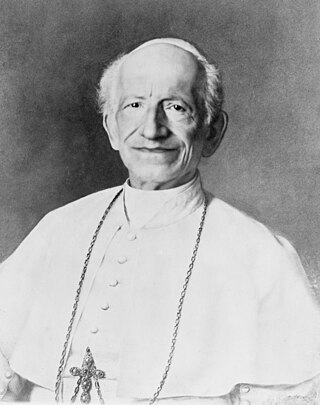
Pope Leo XIII was head of the Catholic Church from 20 February 1878 until his death in July 1903. Living until the age of 93, he was the oldest pope holding office, and had the fourth-longest reign of any pope, behind those of St. Peter, Pius IX and John Paul II.
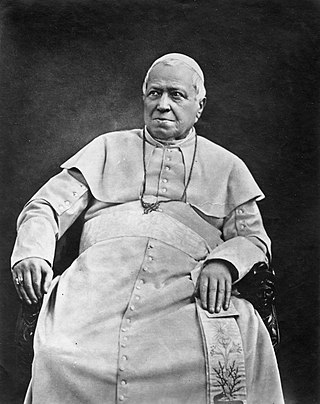
Pope Pius IX was head of the Catholic Church from 1846 to 1878. His reign of 32 years is the longest of any pope in history. He was notable for convoking the First Vatican Council in 1868 and for permanently losing control of the Papal States in 1870 to the Kingdom of Italy. Thereafter, he refused to leave Vatican City, declaring himself a "prisoner in the Vatican".
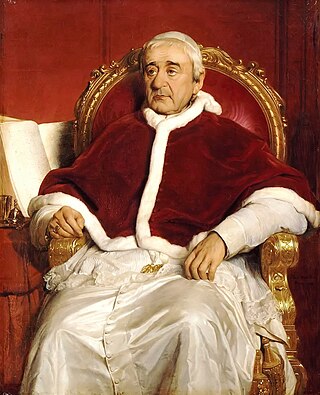
Pope Gregory XVI was head of the Catholic Church and ruler of the Papal States from 2 February 1831 to his death in June 1846. He had adopted the name Mauro upon entering the religious order of the Camaldolese.

Pope Pius VII was head of the Catholic Church and ruler of the Papal States from 14 March 1800 to his death in August 1823. Chiaramonti was also a monk of the Order of Saint Benedict in addition to being a well-known theologian and bishop.
In the history of Germany, the Kulturkampf was the seven-year political conflict (1872–1878) occurred between the Catholic Church in Germany, led by Pope Pius IX, and the Kingdom of Prussia, led by chancellor Otto von Bismarck. The Prussian church-and-state political conflict was about the Church's direct control of both education and ecclesiastical appointments in the Prussian kingdom as a Roman Catholic nation and country. Moreover, when compared to other church-and-state conflicts about political culture, the German Kulturkampf of Prussia featured anti-Polish nationalism, usually not a part of educational curricula or a consideration for ecclesiastic appointments.

The Syllabus of Errors is the name given to a document issued by the Holy See under Pope Pius IX on 8 December 1864, as an appendix to his encyclical letter Quanta cura. It condemns a total of 80 propositions that the pope considered as errors or heresies.
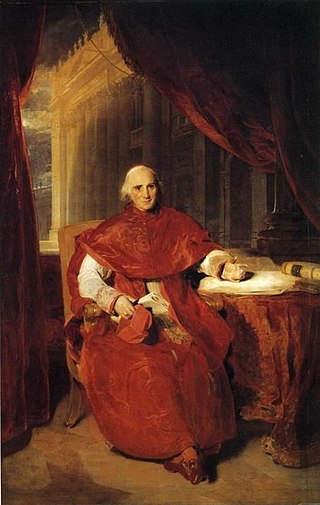
Ercole Consalvi was a deacon and cardinal of the Catholic Church, who served twice as Cardinal Secretary of State for the Papal States and who played a crucial role in the post-Napoleonic reassertion of the legitimist principle of the divine right of kings, of which he was a constant supporter.

Quibus quantisque malis was a Papal Allocution of Pius IX addressed to the Consistory of Cardinals on April 20, 1849, discussing the recent political atmosphere.

Bartolomeo Pacca was an Italian cardinal, scholar, and statesman as Cardinal Secretary of State. Pacca served as apostolic nuncio to Cologne, and later to Lisbon.
The Secretariate of Briefs to Princes and of Latin Letters, or simply the Secretariate of Briefs, was one of the offices of the Roman Curia abrogated in 1967 during Pope Paul VI's reform of the Pontifical court. It was divided into two sections.
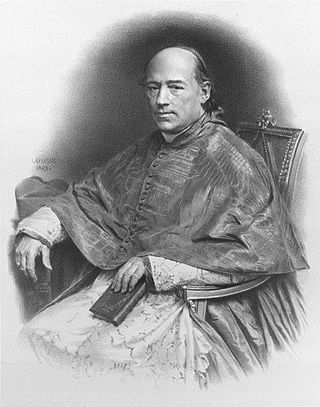
Karl-August Graf von Reisach was a German Catholic theologian, Cardinal and the Archbishop of Munich and Freising.
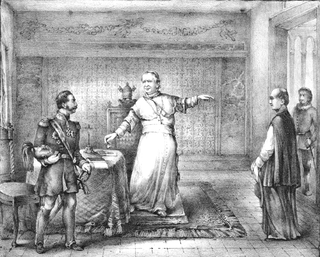
Pope Pius IX and Russia includes the relations between the Pontiff and the Russian Empire during the years 1846–1878.

Tommaso Pasquale Gizzi (1787–1849) was an Italian prelate who rose to the highest ranks of the Catholic Church during the first half of the 19th century.
The 1847 Agreement between the Holy See and the Russian Empire was a diplomatic arrangement entered into on 3 August of that year.

Formal diplomatic relations between the Holy See and the current Federal Republic of Germany date to the 1951 and the end of the Allied occupation. Historically the Vatican has carried out foreign relations through nuncios, beginning with the Apostolic Nuncio to Cologne and the Apostolic Nuncio to Austria. Following the dissolution of the Holy Roman Empire and the Congress of Vienna, an Apostolic Nuncio to Bavaria replaced that of Cologne and that mission remained in Munich through several governments. From 1920 the Bavarian mission existed alongside the Apostolic Nuncio to Germany in Berlin, with which it was merged in 1934.
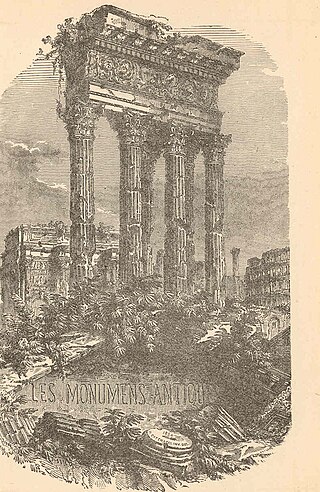
Pope Pius IX and Germany often had tense relations during his long papacy that culminated with the country's anti-Catholic persecutions during the 1870s Kulturkampf shortly before Pius's death. However, the Catholic Church also experienced a period of continuous growth in terms of the number of laity and of clergy.
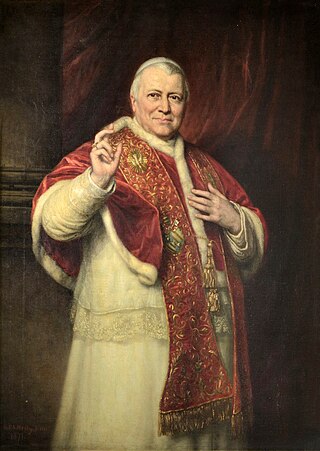
The theology of Pope Pius IX championed the pontiff's role as the highest teaching authority in the Church.

In the time of Pope Pius IX, Poland had long been partitioned among three neighbouring powers and no longer existed as an independent country. The Polish people lived under the rule of the Russian Empire, the Austrian Empire and Prussia.
The modern history of the papacy is shaped by the two largest dispossessions of papal property in its history, stemming from the French Revolution and its spread to Europe, including Italy.
The orders, decorations, and medals of the Holy See include titles, chivalric orders, distinctions and medals honoured by the Holy See, with the Pope as the fount of honour, for deeds and merits of their recipients to the benefit of the Holy See, the Catholic Church, or their respective communities, societies, nations and the world at large.













